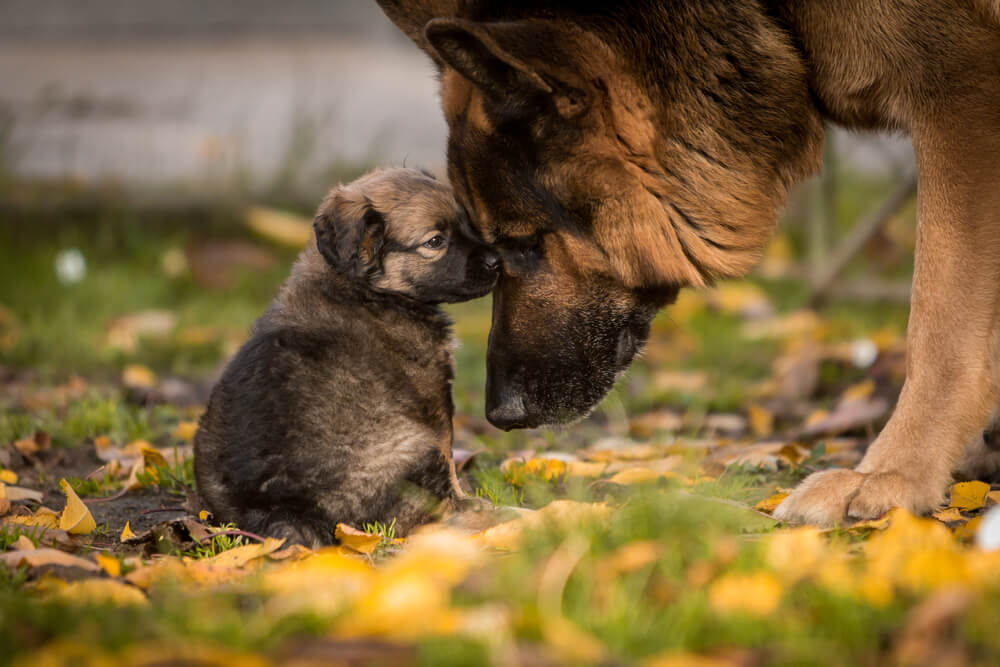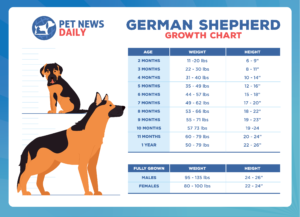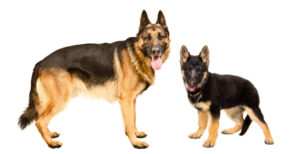As you get to know your new puppy, you may be wondering how big he or she might get. We consulted with our veterinarian, Dr. Jennifer Coates, who reviewed and approved data about puppy weights and sizes, which we then used to create a convenient puppy growth chart. You can use this as a reference to see how your puppy compares to the average.
The chart shows you a German Shepherd’s monthly average weight range during the growing phase. You can also refer to the puppy weight calculator to get an idea of how big your puppy is likely to get.
In This Article
German Shepherd Growth Chart
- 1 year: 50-79 pounds, 22-26 inches
- Fully grown males: 65-90 pounds, 24-26 inches
- Fully grown females: 50-70 pounds, 22-24 inches
Text Transcript of the German Shepherd Growth Chart
| German Shepherd – Age | Weight | Height |
|---|---|---|
| 2 months old 3 months old 4 months old 5 months old 6 months old 7 months old 8 months old 9 months old 10 months old 11 months old 1 year |
11 – 20 lbs 22 – 30 lbs 31 – 40 lbs 35 – 49 lbs 44 – 57 lbs 49 – 62 lbs 53 – 66 lbs 55 – 71 lbs 57 – 73 lbs 60 – 79 lbs 50-79 lbs |
6-9″ 8-11″ 10-14″ 12-16″ 15-18″ 17-20″ 18-22″ 19-23″ 19-24″ 20-24″ 22-26″ |
If you just brought a new German Shepherd puppy home, you’re in for a treat! These are loyal, smart, and noble dogs, and according to the American Kennel Club (AKC), a “dog lover’s delight.”1 Courageous and steady, they will put themselves on the line for their loved ones, and generally become gentle family pets and steadfast guardians.
Because of their intelligence, German Shepherds can get easily bored, so it’s important to spend time with them daily. Teach them new things, give them challenges to overcome, and head out to explore. They are built to please their owners and can learn something within just a few repetitions. Use consistent, positive reinforcement-based methods of training and you’ll be amazed at what your German Shepherd can do.
What Are the Growth Stages of a German Shepherd?
The German Shepherd dog descends from a family of German herding dogs and was originally used to herd sheep. With the rise of modern livestock management and the decline of herding as a canine occupation, the breed was adapted to police and military work, as well as agility, therapy, scent competition, and more.
The breed has an average size of about 24-26 inches high at the shoulder for males and 22-24 inches for females. They weigh between 65-90 pounds for males and 49-70 pounds for females. They have a sturdy, muscular, slightly elongated body with a light, solid bone structure and a bushy tail. The front legs and shoulders are muscular and the thighs are thick and sturdy.
Puppyhood for a German Shepherd is said to last anywhere from five to six months. Within that time, your puppy will experience different stages of growth:
Birth to 3 weeks
The puppy is totally dependent on its mother. It begins to crawl and its eyes and ears open during this time.
3-12 weeks
The puppy begins to walk, play, and interact with the world around him. He’s weaned off mother’s milk and his ears begin to stand upright.
3-6 months
By three months, the pup has all his puppy teeth and begins getting his adult teeth at four months. Called the juvenile period, this is when your puppy will become more independent. He will also reach sexual maturity.
6-18 months
The growth rate slows during this period, but the pup will continue to grow. When he reaches 18 months, he’s said to have reached adulthood, but he may still grow until he’s three years old. Females typically stop growing at two years old.
In general, your puppy will experience her most rapid growth between three and six months. Through all these stages, feed your German Shepherd high-quality dog food appropriate for her age.
Protein should be the top ingredient—something that comes from meat like beef, chicken, or turkey. Avoid byproducts like “chicken byproduct meal” or mystery meats like “meat meal.” 2
Even with high-quality food, you may want to add a little yogurt, cooked vegetables, or eggs to your dog’s food to help add important nutrients. Do be cautious about caloric intake.
An active German Shepherd requires about 1,353-2,100 calories a day in adulthood, depending on weight.3
Avoid feeding table scraps, as well, as they can cause digestive upset. Cooked bones from chicken, turkey, and pork are dangerous as they can potentially splinter and injure your dog. Give only medium-length beef marrow bones.
As your dog grows, keep an eye on her weight. Overweight and obesity in puppies can lead to health problems later in life. A good rule of thumb is to feed puppy-specific foods until your pup reaches full growth, which is usually around 18 months of age.
Monitor your puppy’s weight and body condition score (the dog equivalent of body mass index or BMI), and then adjust your puppy’s food intake as needed.4
You can also check for ideal weight by examining the ribs and waist. You should be able to easily feel but not see the ribs and note a well-proportioned waist when looking at your dog from the top.
How Big Do German Shepherds Get?
You’ve probably heard that you can estimate your puppy’s final size by looking at its paws. Though this can lead to inaccurate results in some breeds, it works pretty well in German Shepherds. Do your pup’s paws look large compared to its legs and body? That means it’s still growing, and will eventually grow into that paw size.
Another indicator of your German Shepherd’s final size is its gender. As with many other animals, males are typically larger than females. Whereas females can weigh between 50-70 pounds, a male can weigh between 65-90 pounds.
If you bought the dog from a breeder, try to see the parents or at least obtain information about them. Based on the parent’s size and weight as well as that of past litters, you can estimate how big your puppy will get.
Another way to estimate your puppy’s final growth weight is to use this simple formula: 5
(Current weight/Age in weeks) x 52.
For example, if your pup is 25 pounds at 16 weeks of age, the formula would look like this:
- (25/16) = 1.57 (rounded up)
- 1.57 x 52 = 82 (rounded up)
The best time to check your German Shepherd with this formula is when they reach about 16-20 weeks of age.
You can also use our puppy size predictor to find out how big your puppy might get as an adult. Or, if you want to see the growth rates of other dogs, we’ve also created a Golden Retriever size chart, Great Dane growth chart, Chihuahua size chart, and Labrador growth chart.
When Do German Shepherds Stop Growing?
German Shepherds tend to be at around 70 percent of their adult size and weight at six months. But they will continue to grow after that until between two and three years of age, depending on their gender. (Males have a longer growth period than females.)
When your dog reaches the age of 18 years old, you can assume he or she is close to their full adult weight and height. If you have any concerns about how your puppy is doing in terms of growth, be sure to check with your veterinarian.
Things That Affect Growth
There is a potential danger that your puppy could grow too fast if fed incorrectly. This can affect skeletal development. If her bones grow faster than they’re supposed to, the body won’t be able to keep up. This can increase the risk of common health problems in the German Shepherd, which include joint dysplasia and osteochondrosis (abnormal development of cartilage on the joints).
You can prevent this by feeding your puppy food that is designed for large breeds. This will help control the rate at which her bones grow, as these foods usually have the optimum ratio of calcium and phosphorus levels.
Most German Shepherds are healthy dogs overall, but they can experience digestive issues like bloat. A more serious variation is called gastric dilatation volvulus and can occur when the stomach “twists” and blocks the digestive tract. This is a life-threatening emergency, so it’s good to be aware of the signs, which include:
- Restless after eating
- Unable to sit or lie comfortably
- Nervous pacing
- Retching in an attempt to vomit
- Rounded, gas-filled stomach
- Salivation and whining
- Difficulty breathing
You can help prevent bloat and its more serious ramifications by:
- feeding a proper diet
- feeding smaller meals twice a day (rather than one large meal once a day)
- avoiding feeding “people food”
- giving the dog time to eat (gulping puts air in the stomach)—separate dogs if you have more than one
- avoiding exercise within an hour before or two hours after eating
- keeping your dog from drinking large amounts of water just before or just after eating
- Monitoring your dog around feeding times
Other possible health issues include degenerative myelopathy (a disease affecting the spinal cord) and elbow and hip dysplasia. A responsible breeder will screen for these issues. If you rescue a dog and aren’t sure of its health history, check with your veterinarian to see if there is anything you need to watch for in your dog.
German Shepherd Weight Calculator
PUPPY WEIGHT CALCULATOR
Frequently Asked Questions
At six months old, a German Shepherd will range from 44-57 pounds and 15-18 inches depending on its gender. (Male dogs are usually larger than females.)
Paw size can be a helpful predictor of how big your German Shepherd puppy will get. The size of the pup’s parents is also a good indicator, as is its gender. You can use our puppy weight calculator above to get an estimate or try this formula when your dog is around 16 weeks old.
(Current weight/Age in weeks) x 52.
The first six months of a German Shepherd’s life is the most rapid growth period, with the time between 2-4 months marking a significant growth spurt. A two-month-old dog will weigh an average of 22 percent of his adult weight, while at three months, he will weigh about 40 percent of his adult weight.
At three months old, your German Shepherd will weigh around 22-30 pounds, depending on its gender. Sizes vary, so as long as your pup is close to this average, she’s probably doing fine.
German Shepherds are active and intelligent, so they can be hyper babies. When they reach one year old, you should notice a difference, but that doesn’t mean the hyper, puppy period is over. Since German Shepherds can continue to grow for up to three years, they may continue to act like puppies until they reach that age. Then the process of calming usually continues through the age of seven or eight, when you may see your dog content to rest more often.
Article Sources
Pet News Daily uses only high-quality sources, including peer-reviewed studies, to support the facts within our articles. Read our editorial process to learn more about how we fact-check and keep our content accurate, reliable, and trustworthy.
- German shepherd dog breed information. (n.d.). American Kennel Club. https://www.akc.org/dog-breeds/german-shepherd-dog/
- New German shepherd puppy. (n.d.). German Shepherd Dog Club of America (GSDCA) – German Shepherd Dog Club of America. https://www.gsdca.org/german-shepherd-dogs/homecoming-german-shepherd-puppy.html
- National Research Council, Division on Earth and Life Studies, Board on Agriculture and Natural Resources, Committee on Animal Nutrition, & Subcommittee on Dog and Cat Nutrition. (2006). Nutrient requirements of dogs and cats. National Academies Press
- Body condition scores | VCA animal hospital. (n.d.). Vca. https://vcahospitals.com/know-your-pet/body-condition-scores
- Puppy growth: What you need to know. (n.d.). Bond Vet. https://bondvet.com/b/puppy-growth



